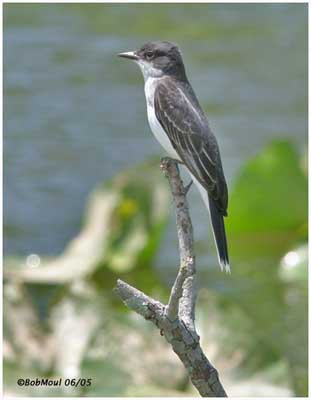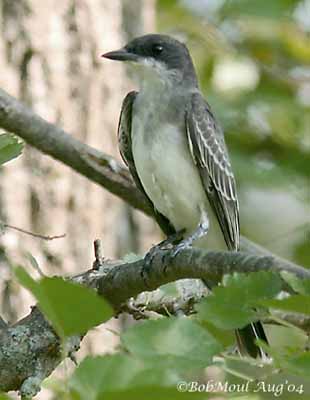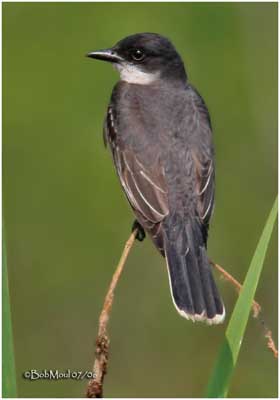
Eastern Kingbird
Tyrannus tyrannus
Passeriforme Order – Tyrannidae Family
BIOMETRICS:
Length : 19-23 cm
Wingspan : 33-38 cm
Weight : 33-55 g
LONGEVITY: Up to 9 years
Eastern Kingbird is a host of the Brown-headed Cowbird, but Kingbird recognizes Cowbird’s eggs and destroys them, breaking the membrane, causing the egg to dry and die.
Courtship displays include flights at about 15 to 20 feet from the ground. Kingbird flies out from a tree top, flying upwards, flying and hovering alternatively. Then, with wings just quivering, it slowly drops almost to the ground, accompanied by a high-pitched, squeaky and tremulous voice “ki-ki-ki…”.
Other nuptial display consists in erected crest and fanned tail, male perched not far from female, twitching its tail downwards several times, accompanied by some tiny notes from both birds.
FLIGHT:
Eastern Kingbird has a fluttering direct flight with shallow wing beats, but it may fly with rapid wing beats. When they fly in large flocks, they fly in loose-straggling flocks of irregular formation.
REPRODUCTION:
Eastern Kingbird’s nest is an open cup situated on a horizontal tree or shrub branch, but this species may also nest in cavities and human-made structures. They usually nest in mid-story or in canopy, near or above water.
Nest is made with weeds, twigs, grass and strips of bark. It is lined with plant down, rootlets and hair. It is a bulky and deep nest.
Female lays 3 to 5 creamy white or pale pink eggs, with darker blotches. Incubation lasts about 16 to 18 days, by female. Altricial chicks are fed by both parents. Young fledge at about 13 to 14 days after hatching. They are fed by adults for about seven weeks.
This species produces only one brood per season. They return year after year very close to their previous nest site.
DIET:
Eastern Kingbird feeds mainly on insects. Fruit and wild berries are consumed on its winter range.
PROTECTION / THREATS / STATUS:
Eastern Kingbirds are common and widespread, with some declines. This species is a common host of Brown-headed Cowbird.
Fr: Tyran tritri
All : Schieferrücken – Königstyrann
Esp : Tirano Oriental
Ital : Tiranno orientale
Nd : Koningstiran
Sd : östlig kungstyrann
Photographs by Bob Moul
His website :
Nature Photography
Text by Nicole Bouglouan
Sources:
A GUIDE TO THE BIRDS OF MEXICO AND NORTHERN CENTRAL AMERICA by Steve N. G. Howell, Sophie Webb - Oxford University Press - ISBN: 0198540124
FIELD GUIDE TO THE BIRDS OF NORTH AMERICA by National Geographic Society - National Geographic Society - ISBN: 0792274512
All About Birds (Cornell Lab of Ornithology)
Bird Web (Seattle Audubon Society)
What Bird-The ultimate Bird Guide (Mitchell Waite)
Wikipedia (Wikipedia, The Free Encyclopedia)

DESCRIPTION:
Eastern Kingbird has dark grey upperparts and whitish underparts, slightly grey on chest. Wings are darker, blackish-brown, with whitish edges. Squared tail has a broad white terminal band.
Head is mostly blackish, with a small red-orange crown patch, often concealed. Black bill is short and small. Eyes are black. Legs and feet are blackish.
Both sexes are similar in plumage. Male tends to keep erected its crown feathers more often than female.

Juvenile resembles to adult, but lacks crown patch. It shows pale-tipped primaries, and has a narrow white stripe on tail.
VOICE:
Eastern Kingbird’s call is a harsh “dzeet” note given in series, and followed by a buzzy note “dzeet-t-t-t-dzeet-zeer”. These calls are usually given by flocks.
HABITAT:
Eastern Kingbird is common in woodland clearings, fields, farm, city parks, roadsides and forest edges. They are often seen near water, and in large flocks in orchards.
It winters in wetland edges and tropical forests.
RANGE:
Eastern Kingbird breeds in North America, except in south western and Pacific coasts.
It migrates through Gulf Coast and Central America, to winter in South America.
BEHAVIOUR:
Eastern Kingbird perches on exposed fences, tree tops or utility poles. It is a highly aggressive bird, even towards large birds. They may attack hawks and crows, and any large bird, perching on the intruder’s back and knocking its head with the bill. It will defend vigorously its territory against other Kingbirds.
However, when wintering in South America, its behaviour changes, and we can see it travelling and eating fruits in large flocks.
Eastern Kingbird is a long-distance migrant, about 1,850 to 6,800 miles.
To feed, eastern Kingbird waits on an exposed perch, and flies out to catch insects on the wing. It may also pick food off vegetation. It is able to pluck berries while flying.
It returns on the same perch after hunting, with a sharp triumphant call.
